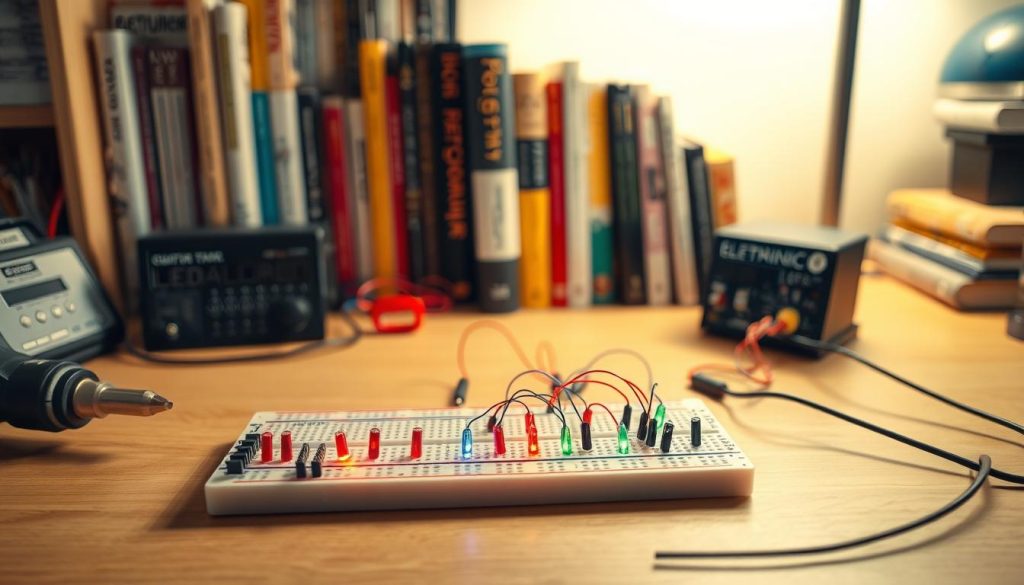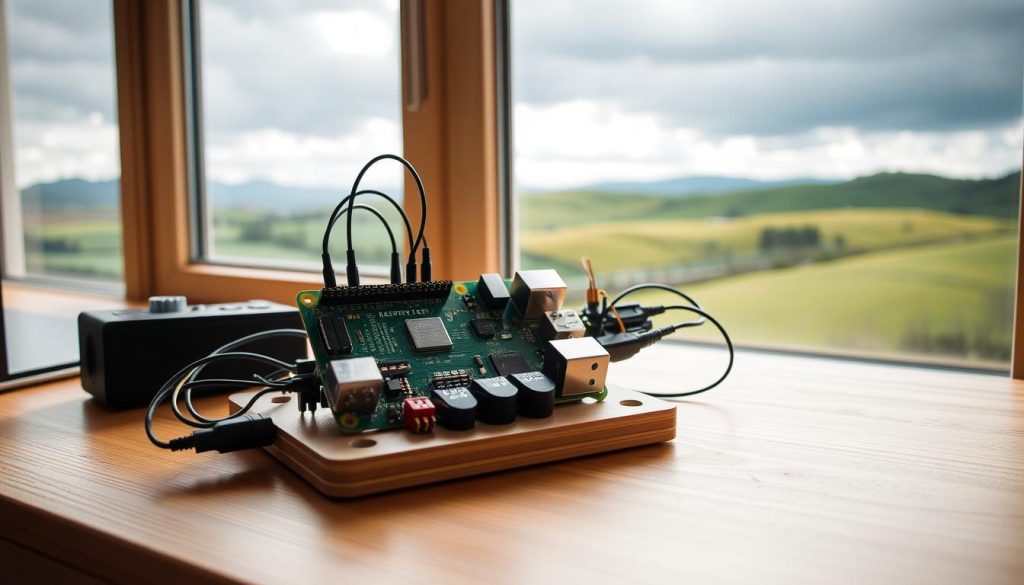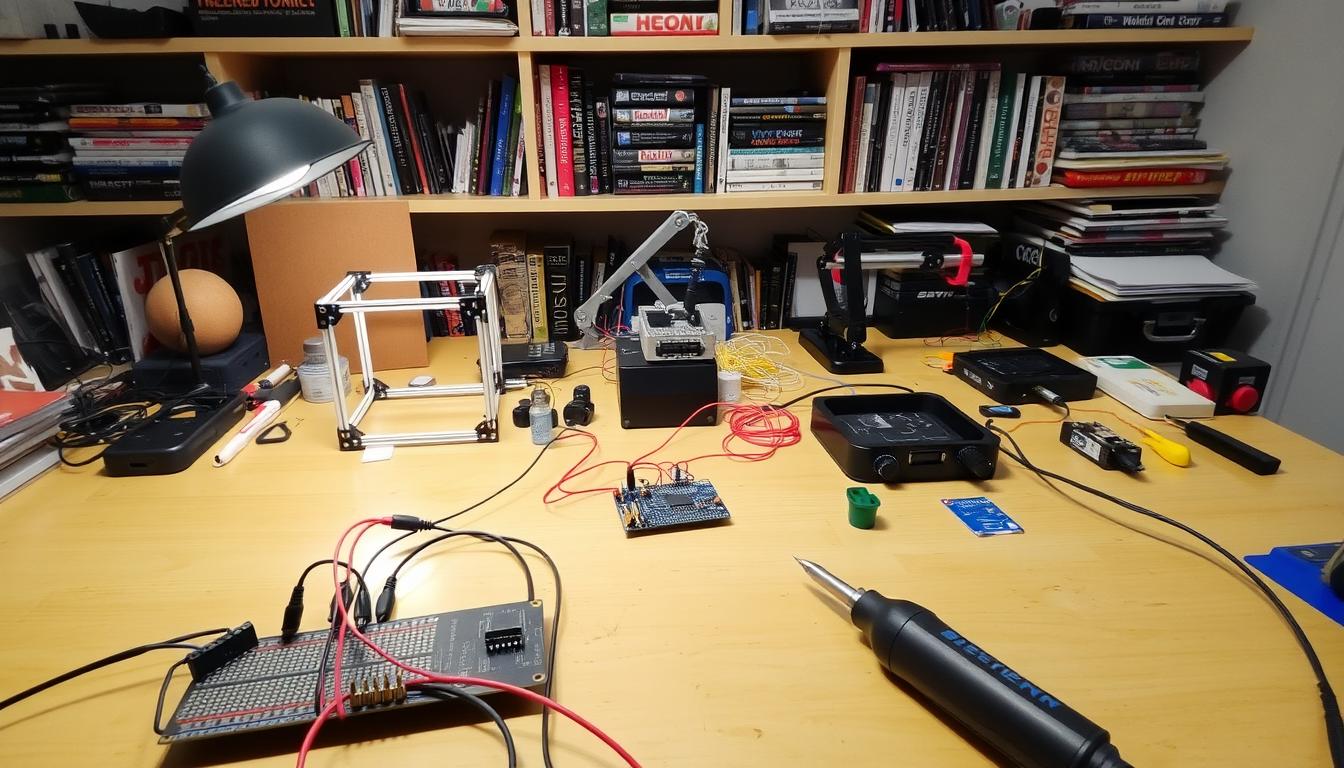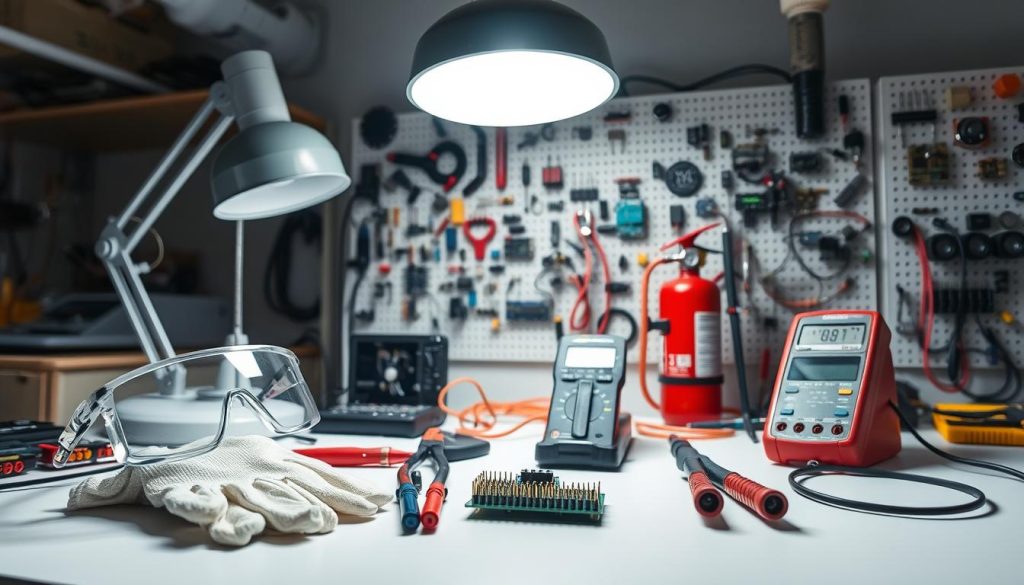Are you curious about bringing your electronic ideas to life, but don’t know where to start? Building simple electronic projects can be a fun and rewarding hobby, allowing you to create something from scratch.
Exploring DIY electronics can seem daunting at first, but with the right guidance, beginners can quickly get started. This article will introduce you to some exciting and easy-to-build projects that will get you started on your electronic journey.
Key Takeaways
Table of Contents
- Simple DIY electronics projects for those new to electronics
- Easy-to-follow guides for building electronic projects
- Tips for getting started with DIY electronics
- Creative ideas for electronic projects
- Resources for learning more about electronics
Getting Started with DIY Electronics
For those new to DIY electronics, understanding the fundamental components and tools is crucial for a successful project. This foundational knowledge will empower beginners to tackle a variety of beginner-friendly electronics projects and DIY beginner projects.
Understanding Basic Electronic Components
Basic electronic components are the building blocks of any electronics project. Components such as resistors, capacitors, and LEDs (Light Emitting Diodes) play critical roles in circuit design. Resistors control the flow of current, capacitors store energy, and LEDs emit light. Familiarizing yourself with these components is essential for creating simple electronics projects for beginners.
Essential Tools for Beginners
To start working on DIY electronics projects, beginners need a set of essential tools. A soldering iron is necessary for connecting components together, while a breadboard allows for prototyping without soldering. Other useful tools include wire cutters, pliers, and a multimeter for measuring voltage and current. Having these tools at your disposal will make it easier to complete DIY beginner projects successfully.
Safety First: Precautions for Electronics Projects
When diving into simple electronic projects, safety should always be your top priority. Ensuring a safe working environment is crucial for enjoying do-it-yourself electronic projects without risking injury or damage.
Electrical Safety Guidelines
To avoid electrical shocks, it’s essential to follow basic safety guidelines. Always unplug your projects when not in use, and never work on a project while it’s still powered. Use insulated tools and avoid wearing conductive jewelry. As Nikola Tesla once said, “The present is theirs; the future, for which I really worked, is mine.” This quote emphasizes the importance of foresight in safety.
“The best way to get a good idea is to get a lot of ideas.” – Linus Pauling
Workspace Setup for Safe Tinkering
Setting up a safe workspace is vital for electronics projects for newbies. Ensure your workspace is well-lit, organized, and free from distractions. Use a non-conductive work surface and keep a fire extinguisher nearby. Organize your tools and components in a way that minimizes the risk of accidents.
| Safety Measure | Description |
|---|---|
| Unplug when not in use | Avoids electrical shock |
| Use insulated tools | Prevents electrical shock |
| Non-conductive workspace | Reduces risk of electrical shock |
DIY Electronics Projects for Beginners: Essential Components
Embarking on DIY electronics projects requires a foundational understanding of the essential components involved. For beginners, having the right components is crucial for successfully completing projects and gaining hands-on experience.
Basic Components Every Beginner Should Have
Every beginner should start with basic components such as resistors, capacitors, LEDs, breadboards, and jumper wires. Resistors are used to control the flow of current, while capacitors store energy. LEDs are great for simple projects, and breadboards allow for easy prototyping without soldering. Here are some key components to get started:
- Resistors
- Capacitors
- LEDs
- Breadboards
- Jumper wires
Beginner-Friendly Electronics Kits
For those new to DIY electronics, kits can be an excellent way to get started. These kits usually include a variety of components and a guide to help beginners complete their first projects. Some popular kits include Arduino Starter Kits and Electronic Component Kits. When choosing a kit, consider what projects you want to build and ensure the kit includes the necessary components.
Simple LED Projects to Build Your Confidence
LED projects are an excellent way for beginners to dive into DIY electronics and gain hands-on experience. These projects not only teach fundamental electronics concepts but also provide a sense of accomplishment as you see your creations come to life.
Blinking LED Circuit
The Blinking LED Circuit is a fundamental project that introduces you to basic circuitry and timing components. It’s a great starting point for understanding how LEDs work and how to control their behavior.
Step-by-Step Assembly Instructions
To assemble the Blinking LED Circuit, start by gathering the necessary components, including an LED, a resistor, and a timer IC. Follow these steps:
- Connect the LED to the timer IC.
- Add the resistor to limit the current.
- Power the circuit and observe the blinking LED.
Circuit Explanation
The Blinking LED Circuit works by using a timer IC to generate a pulse that turns the LED on and off. The resistor ensures that the LED doesn’t burn out by limiting the current.
LED Mood Light
The LED Mood Light project involves creating a circuit that changes the color or intensity of an LED based on a sensor input. It’s a fun way to learn about sensors and color mixing.
Materials Needed
You will need an LED, a microcontroller, a sensor, and some basic electronics components.
Assembly Process
To assemble the LED Mood Light, connect the sensor to the microcontroller and program it to change the LED’s color or brightness based on the sensor’s reading. This project requires some programming knowledge but is a great way to learn about interactive electronics.
LED Dice Project
The LED Dice project simulates the roll of a dice using LEDs. It’s an engaging project that teaches you about random number generation and display.
Components Required
You’ll need several LEDs, resistors, a microcontroller, and a button.
Building Instructions
To build the LED Dice, connect the LEDs to the microcontroller and program it to display a random number when the button is pressed. This project is a fun way to learn about programming and user interaction.

| Project | Components Needed | Learning Outcomes |
|---|---|---|
| Blinking LED Circuit | LED, Resistor, Timer IC | Basic Circuitry, Timing Components |
| LED Mood Light | LED, Microcontroller, Sensor | Sensors, Color Mixing, Programming |
| LED Dice | LEDs, Resistors, Microcontroller, Button | Random Number Generation, User Interaction, Programming |
Fun Arduino Projects for Newcomers
Dive into the world of Arduino and discover exciting projects tailored for beginners. Arduino is a popular platform that makes it easy for newcomers to start creating their own DIY electronics projects.
Setting Up Your First Arduino
Before you can start creating projects, you need to set up your Arduino board. This involves installing the Arduino IDE on your computer.
Installing Arduino IDE
The Arduino IDE is the software that allows you to write and upload code to your Arduino board. To install it, download the latest version from the official Arduino website and follow the installation instructions.
First Program: Blink
Once the IDE is installed, you can start with your first program: the Blink sketch. This simple program makes an LED connected to your Arduino board blink, helping you understand the basics of Arduino programming.
Arduino Temperature Sensor Project
A temperature sensor project is a great way to learn about sensors and data processing with Arduino.
Hardware Setup
To set up the temperature sensor, you’ll need to connect it to your Arduino board. This involves connecting the sensor’s VCC pin to the Arduino’s 5V pin, GND to GND, and the signal pin to one of the Arduino’s analog input pins.
Programming the Sensor
After setting up the hardware, you’ll need to write a simple program to read the temperature data from the sensor and display it on the serial monitor.
Arduino Music Player Project
Creating a music player with Arduino is a fun project that introduces you to playing sounds and music with electronics.
Circuit Assembly
To assemble the circuit, you’ll need an Arduino, a speaker, and some jumper wires. Connect the speaker to the Arduino’s digital output pin and ground.
Coding Your Tunes
To play music, you’ll need to write a program that generates the correct frequencies to produce the desired notes. You can start with a simple melody and then move on to more complex songs.
These projects are just the beginning of your Arduino journey. With practice, you’ll be able to create more complex and innovative projects, exploring the full potential of DIY electronics.
Raspberry Pi Projects for Beginners
Beginners can dive into the world of DIY electronics with Raspberry Pi projects that are both fun and educational. Raspberry Pi is a versatile tool that allows users to experiment with various projects, from simple home automation to complex robotics.
Getting Started with Raspberry Pi
To start with Raspberry Pi, one needs to understand the basics of setting it up and navigating its operating system. Raspberry Pi typically runs on a version of Linux, making it a great way to learn about both hardware and software.
Setting Up Your Pi
Setting up your Raspberry Pi involves installing the operating system on an SD card, connecting it to a monitor, and configuring the necessary settings. It’s a straightforward process that helps you get familiar with the device.
Basic Linux Commands
Understanding basic Linux commands is essential for navigating and managing your Raspberry Pi. Commands like cd, ls, and mkdir are fundamental for file management.
Building a Weather Station
One exciting project for beginners is building a weather station. This project involves using sensors to collect data on temperature, humidity, and pressure.
Required Components
You will need a Raspberry Pi, a temperature sensor (like DHT11), a breadboard, and some jumper wires. The components are easily available and affordable.
Assembly and Programming
Assembling the weather station involves connecting the sensor to the Raspberry Pi and writing a simple script to read and display the data. Python is the preferred language for Raspberry Pi projects, making it easy to program your weather station.

Creating a Retro Gaming Console
Another fun project is creating a retro gaming console. This involves installing emulation software and setting up controllers.
Software Installation
You need to install an emulation software like RetroPie on your Raspberry Pi. It’s a straightforward process that involves downloading the image and installing it on your SD card.
Controller Setup
Setting up a controller involves connecting it to the Raspberry Pi and configuring it within the emulation software. This allows you to play classic games with a nostalgic feel.
These projects showcase the versatility of Raspberry Pi and provide a great starting point for beginners in DIY electronics.
Troubleshooting Common Issues in Electronics Projects
As you embark on electronics projects for beginners, learning to troubleshoot can save time and frustration. Troubleshooting is an essential skill that helps you identify and fix problems in your DIY electronics tutorials. Whether you’re working on a simple LED circuit or a complex Arduino project, being able to debug your work is crucial.
Circuit Debugging Techniques
Effective circuit debugging involves a systematic approach. Start by checking your circuit’s power supply and ensuring all connections are secure. Use a multimeter to measure voltage and current at different points in your circuit. Verify that your components are correctly placed and that there are no short circuits. If your project involves a microcontroller like Arduino, check your code for logical errors or syntax mistakes.
Resources for When You Get Stuck
Even with careful planning, you might encounter issues that you can’t resolve on your own. Fortunately, there are many resources available to help. Online forums like Reddit’s r/Arduino and r/DIY, as well as Stack Overflow, are excellent places to ask questions and get help from experienced makers. Additionally, many component manufacturers provide detailed datasheets and application notes that can guide you through troubleshooting specific components.
| Resource | Description |
|---|---|
| Online Forums | Communities like Reddit and Stack Overflow where you can ask for help. |
| Component Datasheets | Detailed documents provided by manufacturers for specific components. |
| Tutorial Videos | YouTube channels and websites offering step-by-step guides and troubleshooting tips. |
Conclusion: Taking Your Electronics Skills to the Next Level
Now that you’ve explored various diy electronics projects for beginners, it’s time to take your skills to the next level. By completing simple LED projects, Arduino, and Raspberry Pi projects, you’ve gained hands-on experience with beginner-friendly electronics projects.
To continue improving, try experimenting with new components, such as sensors, motors, or displays. You can also attempt more complex projects, like home automation or robotics, using the knowledge gained from this article.
For further learning, consider visiting online resources, such as Adafruit or SparkFun, which offer tutorials, guides, and projects for electronics enthusiasts. Joining online communities, like Reddit’s r/LearnElectronics, can also provide valuable support and inspiration.
By continuing to explore and learn, you’ll be able to create innovative diy electronics projects and expand your skills in the field of electronics.

